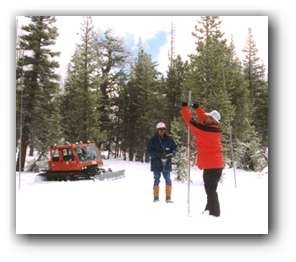 The cut-off for determination of the water year for 2014-15 happened on April 1st. Though recent storms lifted the snowpack some, the overall picture looms well below normal.
The cut-off for determination of the water year for 2014-15 happened on April 1st. Though recent storms lifted the snowpack some, the overall picture looms well below normal.
The Department of Water and Power’s measurements show the Mammoth Pass Snowpack at 18.3 inches of water content – just above the driest year. Mammoth Community Water District Manager Pat Hayes called that reading 42% of normal. Hayes said the Water District remains in Level 1 water restrictions and asks customers to conserve 10% over last year’s use. He advised customers to check the MCWD website for more.
The rest of the snow measurements on DWP’s website show this: Rock Creek at 12% of normal. South Lake, 41%. Big Pine Creek, 29%. Cottonwood Lakes, 19%. The Mammoth Pass reading did make it above the driest year of 1976-77. The environment of the Eastern Sierra will suffer, Los Angeles will have less water to export and management of water locally will feel the pressure.
DWP’s website shows actual precipitation measurements as well as snow. The percentages are equally grim. Long Valley sits at 28% of normal, Bishop, 40%. Big Pine, 47%. Independence, 55%. South Haiwee at 36% and Los Angeles precipitation measures 19% of normal to date.
Inyo County will now go through the difficult process with DWP on a pumping rate for the year and other water management issues. Earlier, Inyo Water Director Bob Harrington had expressed the desire to work with DWP more closely due to obvious drought conditions. He said there have been some discussions.
The schedule that unfolds from here includes DWP’s April 1st run-off forecast, submission of DWP’s pumping plan on April 20th, Inyo County’s comments ten days later, a Technical Group meeting ten days after that and a final pumping plan ten more days later.


















It could get worse — and stay worse for a long time. http://guardianlv.com/2014/02/california-facing-mega-drought/ On January 17th of this year, Governor Jerry Brown issued a state of emergency over the severe drought conditions in California. Today, Brown announced that California is facing what scientists call a mega drought. A mega drought… Read more »
Tough decisions all around. It seems like the logical Pumping Plan should be 40% of average at most considering this is the third year of drought. I wonder if the Long Term Agreement has any language regarding these conditions?